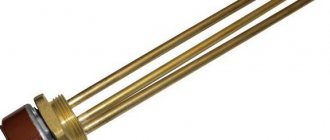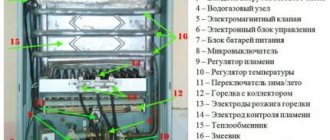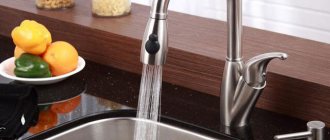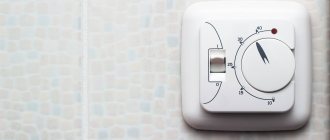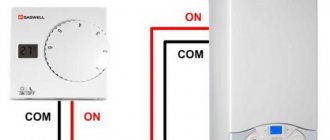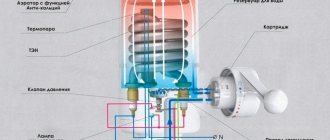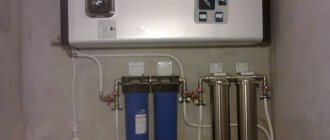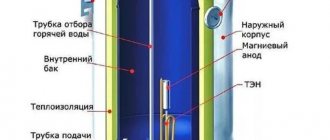Comfort at home is the basis of a person’s normal life, so without hot water we are no longer comfortable. Repairs of heating mains in the autumn-winter period and subsequent shutdowns of hot water supply for a week force people to heat water on the stove. A modern solution to the problem is to install an instantaneous water heater. This compact device will provide your family with hot water at any time of the day and in the required quantity.
Rules for connecting an instantaneous water heater, expert advice
Not every house or even apartment can be connected to a central hot water supply system, so residential property owners need to install various devices to ensure the constant availability of hot water in the house. An excellent choice for this is the installation of an instantaneous water heater, which acts as a high-quality, reliable and durable equipment that heats the water as it enters the plumbing fixtures. These devices are presented on the market in many types, differing in power, appearance, size, cost and other parameters. It is important to choose the product wisely, and also to know how to connect the instantaneous water heater to the main plumbing fixtures at home. It is not difficult to carry out all the processes, so you can implement them yourself. It is necessary to distinguish between a flow heater and a storage heater, since they are connected to the power supply system differently.
Criteria for choosing a water heater
The main parameter of the device is energy consumption. This determines how much electricity it will use and how hot the water will be. For an apartment during seasonal outages, devices of 3-7 kW are suitable. They connect to a 220 V household outlet. For a private home or industrial premises, it is better to buy a unit from 18 kW, it operates from a 380 V network.
An instantaneous water heater does not impose restrictions on the volume of heated water.
According to the control method, water heaters are divided into electronic and hydraulic. The first ones are regulated by microcontrollers, all parameters are precisely adjusted. Their disadvantage is their high price. Hydraulics switch modes using water pressure. It is easier to operate and repair.
Popular models
For an apartment, it is better to choose the Thermex Stream 700 device. It comes complete with a shower head, a faucet with an adapter and a set of fasteners. The device is simple - on the left side there is an inlet for cold water, on the right there is an outlet for hot water. There is a filter that will trap particles larger than 2 mm. Maximum temperature: 50°C.
Another good model for an apartment is the Electrolux NPX6 Aquatronic Digital. Power - 5.7 kW, this is enough for a small family. The device has electronic control. The advantage is stable heating and easy installation. The disadvantage of the device is its low power for the winter period.
Third place in the rating is Timberk WHE 5.5 XTR H1. Heats water up to 60 °C. It consumes electricity economically, but at the same time has good performance. Installed vertically with bottom connection.
Required tools and materials
The instantaneous water heater must be connected using suitable tools and materials. The whole process is divided into three large stages:
- the connected element is mounted on the selected location on the wall of the living room;
- it connects to electricity;
- then connected to the cold water supply system.
Schemes of instantaneous water heaters of different types have almost the same parameters, so installation of any type requires tools and materials:
- to install the structure, a drill equipped with suitable drills is required, and their choice depends on what material the wall of the room where installation work is planned to be made of, since standard drills for concrete will not be suitable for tiled coverings;
- to fasten the device, dowels with self-tapping screws are required;
- to connect to electricity, a copper wire with three cores, equipped with high-quality double insulation, is required, and the cross-section must be at least 2.5 sq mm;
- hammer, screwdrivers, gas wrench, pliers, open-end wrench;
- FUM tape is used to seal various connections;
- To connect an instantaneous water heater to a cold water supply system, a pipe is required, and metal-plastic products are considered the best choice.

When choosing the location of the structure, it is taken into account that it should be at the level of the heads of adults to prevent overheating of the equipment or its filling with water.
Stages of connecting an instantaneous water heater
After the preparatory work, you can begin the actual installation. It is divided into several large stages, and each of them is significant and important, since the ideal result of the work depends on the competent completion of all tasks.
Selecting a location
Initially, it is important to decide on the location of the equipment. It is necessary to install the instantaneous water heater correctly, therefore, when choosing the installation location, take into account the recommendations of specialists:
- it is important that using the design is convenient for direct users, since usually there are different buttons on the external panel for controlling the boiler;
- It is not allowed for the device to get wet during operation, as this can cause a short circuit, as well as breakdown of expensive equipment;
- when choosing a location, the convenience of connecting electrical wiring and cold water supply pipes to the water heater is taken into account;
- It is allowed to install on any wall, since flow-through products are not large in size, so there will be no significant impact on the wall.
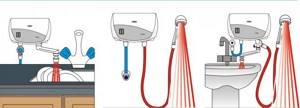
As soon as the optimal location for installing an instantaneous water heater is chosen with your own hands, markings are applied to it. To do this you need to use a level and a pencil.
Much attention is paid to marking, since it is not allowed for the water heater to be installed with any distortions or unevenness, as this will negatively affect the efficiency of its use, as well as its service life. Using the cover of the product, the locations of the mounting holes are marked on the wall. After this, using dowels and self-tapping screws, the structure is attached to the wall of the room when oriented towards the pre-applied markings.
Most often, instantaneous water heaters are produced complete with all the necessary elements for fastening, but you often have to deal with the fact that the dowels are too short, so it is impossible to attach the equipment to walls that have a significant layer of plaster. Therefore, you will have to additionally purchase suitable fasteners.
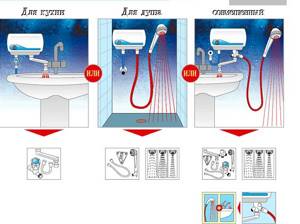
Connection to water supply
Next, you need to figure out how to connect an instantaneous water heater in an apartment to a cold water supply system. To do this, select one of the possible methods. A simple method is usually used by beginners. He assumes that the watering can is first unscrewed from the shower hose, after which it is attached to the water inlet of the equipment. The mixer is then installed in the shower position, after which you can use the heater for its intended purpose. If the handle is turned to the tap position, cold water will flow from the tap. This method is usually used to temporarily solve a problem associated with the lack of hot water in an apartment, for example, when there is a breakdown in the centralized system. It is considered unsuitable for the main method of obtaining hot water.
The second rather complex method involves installing boilers, which are used as the main elements for producing hot water. To do this, use a tap designed to connect a washing machine. A tee is purchased, and a fum tape is also prepared. After attaching the tee to the outlet, a tap is installed that allows you to regulate the flow of cold water to the water heater, and this will also make it easier to control the set temperature in the equipment. When choosing the location of the tap, it is taken into account that it should be located in an accessible and convenient place, and it should not be blocked by any boxes or other elements. A pipeline is laid from the water heater to this tap, and most often metal-plastic pipes are used for this. It is allowed to use plastic pipes or use flexible hoses.
For an aesthetic appearance of the entire room, it is advisable to lay the pipes in such a way that they are not visible, and if this is not possible, then they are covered with boxes.
Thus, having figured out how to connect instantaneous water heaters to the water supply system, every residential property owner can easily cope with this process on their own. If pipes are used for connection, then all threaded connections must remain freely accessible, so they cannot be walled up in walls or covered with any sealed and integral structures.
Preparatory work
Preparation for installation begins with checking the electrical network. Actually, this must be done before purchasing the device. Otherwise, you can waste your money - buy a powerful water heater, and then find out that your apartment’s networks simply won’t handle it.

Stores sell instantaneous water heaters with a capacity from 3 to 27 kW.
According to the number of phases, flow-throughs are divided into:
- single-phase: their power does not exceed 8 kW. These devices are suitable for installation in apartments;
- three-phase - 12-27 kW. With their help, you can provide hot water to a country house or public building.
Typically, in city apartments a water heating device with a power of 6 kW is installed.
For its operation, a current of 27 A will be required. In old houses, electric meters are designed for 32-40 A.
But not only the water heater will work in the house: a large number of electrical appliances are used in everyday life.
If the old wiring can withstand a low-power device, then you will have to install a new one under a powerful water heater.
Therefore, a separate cable of the appropriate cross-section is laid under the water heater.
For example, for a 6 kW device this parameter will be 4 mm2. For seven to eight kilowatts you will need a cable with a cross section of 5 mm2. For a more powerful device - 13-16 kW - a line with a cross-section of 10-16 kW is laid.
You can check the permissible power of the network as follows:
- Find out which circuit breaker is installed in front of the electric meter - at the entrance to the apartment.
- Multiply two values: the rated current of the machine and the operating voltage of the network.
So, with a 16 A machine, the permissible power will be:
16 x 220 = 3520 (3.52 kW).
Device installation location
Next, decide where to install the heater. This decision is greatly influenced by the type of device. Gravity heaters are installed at the water point - above or below the sink, or on the side of the tap. In this case, it is advisable to place the electrical appliance in such a way as to exclude the possibility of flooding it with water. Although IP24 and IP25 models have good moisture protection.
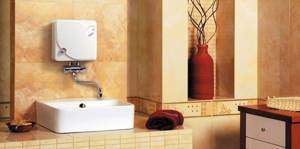
Vodogrei
The installation location must be selected in such a way that switching on and mechanical adjustment of pressure and temperature do not cause inconvenience to the user.
If you plan to permanently install the heater, check the condition of the piping.
Drilling holes for brackets
The preparatory stage ends with drilling holes and installing dowels in them.

Brackets for hanging the water heater are included in the kit, so all you have to do is mark the mounting locations on them.
This is done like this:
- Take a level and a pencil in your hands and mark the installation location of the groover.
- Remove the top cover from the device, attach it to the wall, drawing the level horizontally and marking the centers of future holes.
- Using a drill, drill holes for the fasteners.
- Install dowels and screws to secure the water heater to the wall.
Factory delivery of flow ducts is usually completed with fasteners. But in some cases they are not suitable - for example, when hanging the device on a wall with a thick layer of plaster. Therefore, decide in advance what length of hardware you need and buy them separately.
Common mistakes
It is actually very easy to connect an instantaneous water heater to various communication systems, but if you do not understand this issue in advance and also do not have operational experience, then there is a high probability of making several serious mistakes. They negatively affect the performance and service life of all equipment.
The most common mistakes are:
- such powerful equipment is connected to the existing electrical system without isolating a separate line, which leads to a reboot of the system, since it cannot cope with such a load, therefore it often knocks out traffic jams, and there is also instability in the operation of various electrical appliances;
- the device is turned on before it is connected to the water supply system, which can lead to disruption of its operation;
- unsuitable pipes or other elements are used to connect it to the water supply;
- the pipes are laid in a convenient way, but it is not taken into account that they significantly spoil the appearance of any room, so after installing the heater, the interior of the room may deteriorate;
- the power of the device is incorrectly calculated, so cold or hot water flows from the tap, which leads to a lack of comfort in its constant use for its intended purpose;
- electrical wires were connected incorrectly, resulting in short circuits or other problems in the performance of the equipment;
- the location of the water heater is not chosen correctly, so difficulties and inconveniences arise in the process of using it, associated with the inability to freely regulate its functions.
Thus, every person who independently installed a instantaneous water heater on their own encountered certain difficulties, therefore, in order to prevent possible mistakes, it is recommended that you first carefully study the correct instructions. As a result, proper installation of the device is ensured, guaranteeing a constant supply of warm water to the residential property. This significantly increases the comfort of living in any apartment or house that does not have a connection to a central hot water supply. An instantaneous water heater is often installed as an auxiliary source of hot water in case there are problems in the central system.
Source
Design of water heaters and their types
First you should choose the type of heating device that is most suitable for your case. To do this, it is worth analyzing and determining what requirements the product must meet, as well as its parameters and functions.
Water heating devices may vary in type of power supply and functional design. The power source for water heating devices can be natural gas or electricity. According to the type of operation, the units are available for running water and with a storage tank.
Storage water heaters
Water in storage systems is heated in a container connected to the water supply. This type of heating device is especially popular. This can be argued by the affordable cost of the devices, as well as the lack of special conditions for the installation of electrical equipment.
Flow type devices
The functional design of instantaneous water heaters is that the water is heated by passing through a special sleeve equipped with an electric thermoelement. Products of this type are mounted directly on the mixer, which is connected to the water supply.
This system provides water heating within 30 degrees. A significant disadvantage of such devices is that electrical devices have high energy consumption. This is unprofitable from an economic point of view. In addition, not all houses have electrical wiring that allows the operation of such powerful water heaters.
According to the energy consumption class, flow heating systems are divided into two types - single-phase and two-phase. Another difference is what type of heating element is used in the device. This can be a heating coil or a thermoelectric heater. If tap water has a high salt content, the best choice would be to install a instantaneous water heater equipped with a spiral. In addition, devices with heating elements consume 20–30% more electricity. An internal heating system will be the best option for seasonal use, for example, in a country house.
One of the main advantages of flow-type devices is the convenience and ease of installation. This type of work can be performed by a completely untrained person. To do this, you do not need to have any skills in either plumbing or electrical engineering.
Most of these devices are designed to be placed on the wall in close proximity to the faucet in the kitchen area or in the combined bathroom in order to reduce heat loss. Flow-type heating devices have a low weight, and therefore they do not require major fasteners, as is the case when installing a boiler in a bathroom. To do this, you can use simple fasteners and hardware. Depending on the model, heating units may be located above the faucet or under the sink. One of the advantages of such devices is the possibility of hidden installation. For this you can use plastic wall panels.
You can find out how to install a instantaneous water heater in the bathroom by reading the instructions included with the product. It must be equipped with a connection diagram for the instantaneous water heating system.
Heaters operating on this principle have the following disadvantages:
- high energy intensity
- from 5 to 30 kilowatts; - For correct operation of the equipment, a certain level of pressure
in the water supply system is required; this excludes the possibility of using instantaneous water heaters on the top floors of apartment buildings.
Flow-type devices are optimal for installation in small rooms with a small number of occupants. In this case, the apartment should be located on the lower floors.
How to install an instantaneous water heater for an apartment?
The presence of hot water is a prerequisite for a person’s comfortable living. In its absence, he experiences certain inconveniences. Nowadays, any apartment has both cold and hot water. However, interruptions in the supply of the latter often occur. This makes a person think about how to eliminate the shortage of hot water and ensure its uninterrupted supply. Most often, the choice is made in favor of purchasing a water heating device. There is a large selection of units available on the market today.
The principle of flow-through water heating
The water flow is heated as it passes through the heating element. The more powerful it is and the lower the pressure, the higher the temperature will be. The boiler has small dimensions due to the absence of a storage tank. For the same reason, after opening the tap, hot water flows immediately: there is no need to wait until the entire volume of the device heats up.
Internal structure of the device
The main part is the heating element.
It is controlled by a relay, which is monitored by temperature and flow sensors. If the water flows weakly, the mechanism does not start. The temperature sensor protects the structure from overheating.
The problem of providing electricity
The disadvantage of flow-through devices is their high electricity consumption. The power is approximately 7 kW, which is comparable to the consumption of an entire apartment.
Main stages of equipment installation
If you have purchased an electric instantaneous water heater and want to connect it, you should know that the installation process of this equipment includes 3 main stages:
- the first stage involves installing the installation on the wall in a selected location in the apartment;
- at the second stage, the unit is connected to the electrical network;
- completion of the work is carried out by connecting the installation to the water supply and installing all the necessary attachments to the device.
If you do not have experience in installing a water heater, then it is better to contact specialists to avoid mistakes and ensure high-quality installation. In this case, you will not encounter problems when using the device.
Materials for installing a water heater
If you are determined to install an electric water heater on your own, then you should prepare for the upcoming work. First of all, you need to take care of the availability of certain materials and tools.
Materials and tools:
- Drill. In addition to this, you should have at your disposal a special drill designed for working on concrete.
- Self-tapping screws, dowels. They will be used to mount the unit on the wall.
- Three-core copper wire with double insulation. The cable cross-section should not be less than 2.5 square meters. mm. Only a specialist can calculate the appropriate cable cross-section for this equipment. If the manufacturer does not indicate any instructions regarding the cable cross-section in the equipment instructions, then you need to contact an electrician.
- Screwdriver, hammer.
- Gas key.
- Fum tape.
- Pliers and open-end wrench 22.
- Metal-plastic pipe. It will be needed to connect the water heater.
- Fittings, taps, and besides them valves and tees.
The nuances of installing a water heater
Modern water heating installations are designed in such a way that they can be mounted on a surface above the level of a person’s head .
This will make it possible to avoid filling the device with water and overheating, which can lead to loss of operation of the unit. The design of a modern boiler is such that it must be installed level. The presence of distortions and unevenness is unacceptable. If we talk in more detail about the installation of an electric instantaneous water heater, we note that the installation work is highly complex. During work, attention must be paid not only to connecting the water supply pipes, but also the electrical wiring.
The main problem is that a flow-type boiler cannot be connected to a regular outlet. A separate cable is used , through which it is fed to the shield. This work is very complex, so to connect the water heater to the electrical network, it is better to invite a qualified specialist who has experience and knows how to do everything correctly.
The first thing that every person who is going to connect a boiler should pay attention to is to find out whether the electrical wiring in your home is designed for the additional load of an electric boiler. The thing is that the number of household appliances in our homes today is noticeably greater than it was three decades ago, when the wiring was laid. Therefore, when installing such high-power equipment, you need to take into account whether the electrical panel installed in your home can handle such a load.
To avoid problems with the electrical wiring during operation of the electric boiler, it is necessary to reconstruct it and replace the power cable. New machines for input and output lines should be installed. At the input it is necessary to place machines designed for 50-63 Amperes . To power an electric water heater, it is better to use a three-wire cable. In addition, it is necessary to correctly perform the installation of the RCD.
Connection to water supply
In addition to connecting to the electrical network, an equally important point when installing an electric boiler is its connection to the water supply system. When installing such equipment, they first do the electrical wiring, then move on to connecting to the water supply network. Water will flow through the water heater pipes, which will not be heated by the device.
Connect to the power supply
First, the water heater is connected to electricity, and then to the water supply.
If the device is powered from a wall outlet, there will be no problems connecting it. We will consider the case when the device is connected to the electrical network using a cable. The sequence of actions will be as follows:
1. Remove the front panel of the water heater (most likely it is secured with self-tapping screws). 2. Connect 3 wires to the terminal block, focusing on their color. The yellow ground wire must be connected correctly and firmly. Do not use a instantaneous water heater without grounding - it is dangerous! 3. Tighten the mounting screws.
